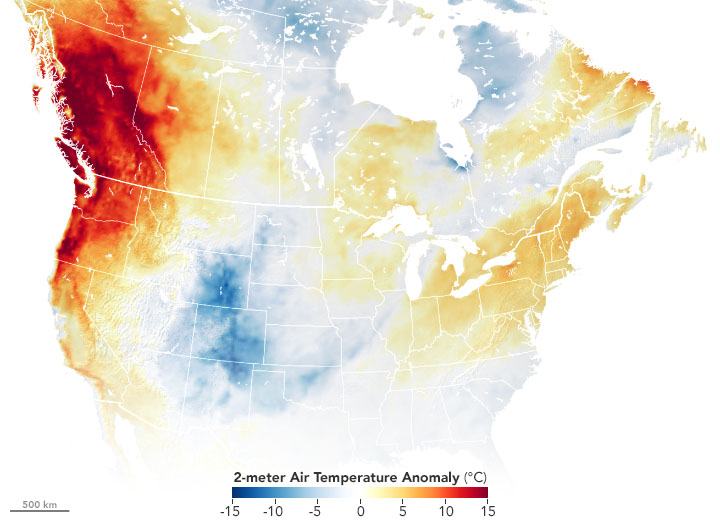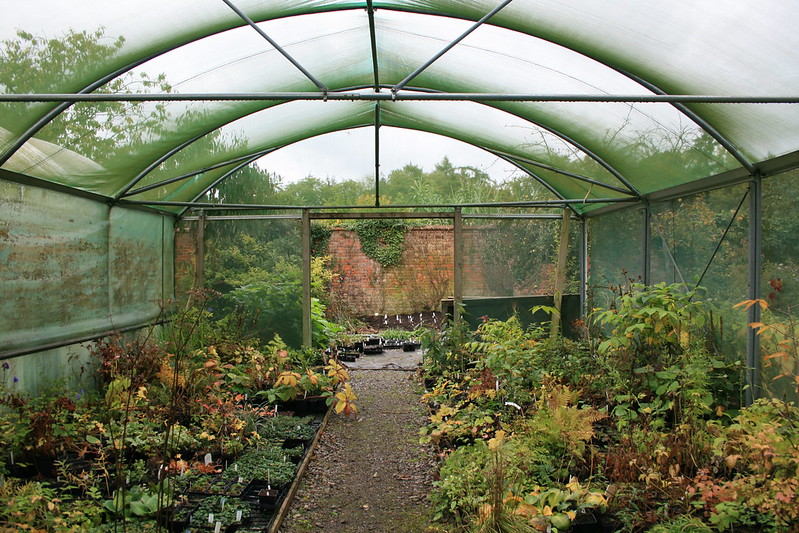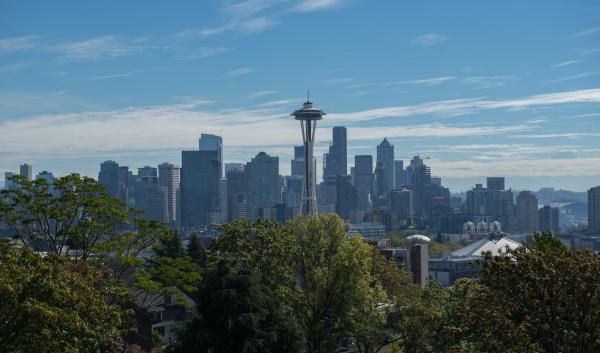 A map of the magnitude of temperature anomalies–temperature that was higher or lower than the long-term average-that occurred during the 2021 heat dome. NASA Earth Observatory.
A map of the magnitude of temperature anomalies–temperature that was higher or lower than the long-term average-that occurred during the 2021 heat dome. NASA Earth Observatory.
For a region with average high temperature in June in the 60’s or 70’s depending on location, this heat wave caused devastating impacts. The heat dome caused over 250 deaths in the U.S. and more than 400 in Canada. This event also put stress on hospitals, with hundreds of heat-related emergency visits reported for Oregon, Idaho, Washington, and Alaska. Elderly people, homeless people, people who work outside, and people who do not have access to air conditioning are especially vulnerable to these impacts. In addition to health impacts, there were impacts to infrastructure. In Washington, the heat caused sections of Interstate-5 and State Route 162 buckle, causing some lanes to be closed. In Portland, the heat exceeded the design limits of the TriMet MAX system, melting train power lines and shutting down trains for a day.
 Blackberries damaged by heat. Credit: Oregon Department of Agriculture.
Blackberries damaged by heat. Credit: Oregon Department of Agriculture.
Agriculture was also affected by the heat dome. Plants usually control their temperature through transpiration, releasing water through their leaves. In extreme temperatures, plants cannot transpire, and they have trouble cooling down. Even if they have plentiful water available in the soil, they will not use it to cool themselves down because of a stress response that causes them to close the pores (stomata) on their leaves. Some crops like blackberries and raspberries may pull water from their fruit. This can make fruits soft or dry, and the heat dome greatly reduced yields, with some farmers experiencing as much as 100% crop loss in parts of Willamette Valley.
In parts of the Northwest, trees and forests were damaged by the heat as well. This was most noticeable for forests in the Coast Range, where trees are not adapted to such extreme high of temperatures and were in earlier stages of seasonal development. The heat made conditions worse for trees that were already suffering from the previous two years of drought, and trees displayed signs of scorched leaves. Some trees like western hemlock dropped their needles, leaving the trees bare. Many young saplings and seedlings died in the heat, and some Christmas tree farmers experienced thousands of dollars in damage.
What caused the 2021 Northwest Heat Dome?
This heat wave, or heat dome, was caused by several factors coming together. In general, heat domes are caused by high-pressure systems that persist in a location. The events that led up to the 2021 Northwest heat dome are complex, but a high-pressure system caused the heat dome itself. The high-pressure system also blocked the cooling maritime winds and prevented clouds from forming, allowing the sun to continue to warm the air and land surface. As it got hot, that warm air rose and was pushed back down by the high-pressure system, further heating the air. This cycle continued until eventually atmospheric patterns changed and the high-pressure system was able to move on.
Analysis from one scientific study of this event shows that climate change played a role in the event’s occurrence. The warming of 1.2°C since pre-industrial times (1850-1900) increased the probability of an event this extreme occurring. According to this study, a heat dome of this magnitude is estimated to be 150 times more likely in today’s climate than compared to the pre-industrial climate. Future warming would make heat events like the 2021 heat dome more frequent and intense.
Planning for Future Heat
With continued warming, our future odds of experiencing once "unprecedented" events like the 2021 heat dome will grow. Knowing that these events are more likely because of climate change allows us to make more climate-informed decisions and prepare for future heat events to reduce their impacts. Residents of the Northwest can monitor heat risk and take measures to prepare. Builders can consider changing building design to prepare homes and other buildings for this extreme heat. Electric companies can prepare backup plans for episodes of extreme heat that result in high power demands. We can also take action to reduce greenhouse gas emissions and store more carbon to reduce the effects on global climate.
 A shade cloth used over a high tunnel to help plants stay cool in high heat.
Credit: Emma Doughty
A shade cloth used over a high tunnel to help plants stay cool in high heat.
Credit: Emma Doughty
For farmers and ranchers, many options are available. Farmers can take measures to be prepared for working in extreme heat, such as changing work schedules to avoid the hottest times of the day and providing cooling and shade stations for workers. For crops, they can plant varieties that mature at different times of the year to prevent total loss if heat waves come early or late in the season (e.g., cherries). Farmers can also improve soil health which increases water holding capacity and makes plants more resilient to extreme heat.
They can also install cooling systems on their farms such as shade nets or water misting systems to help both workers and crops. For crops, some of these cooling systems can be monitored via smartphone applications and even smartphone cameras. Shade and misting can also help ranchers to keep herds cool during heat waves. In addition to these tools, ranchers help cattle cool down by reducing high-energy foods and providing plentiful cool, clean water.




